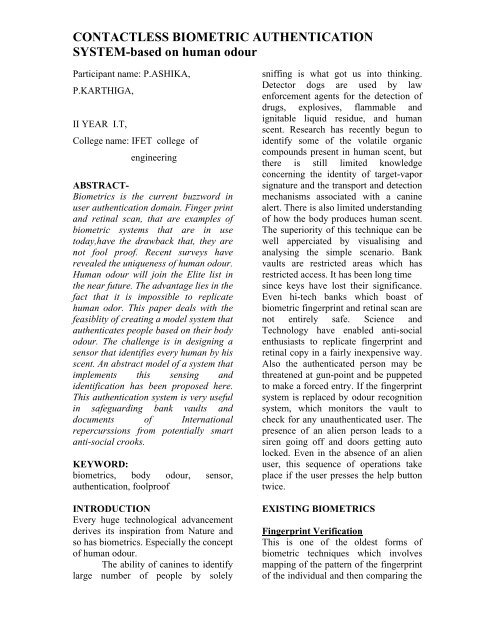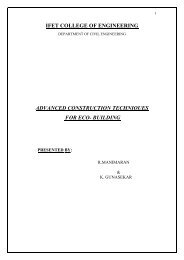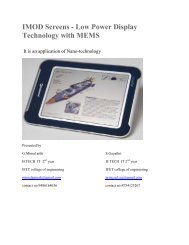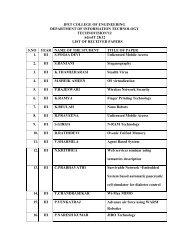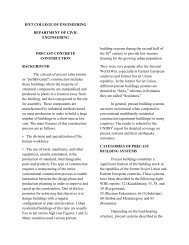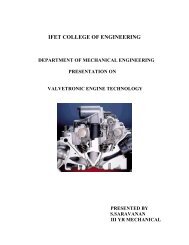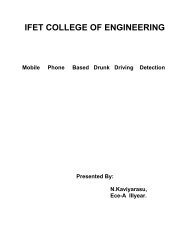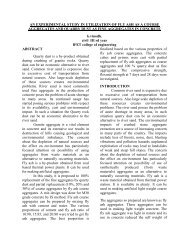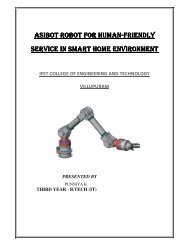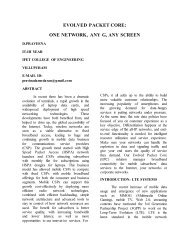CONTACTLESS BIOMETRIC AUTHENTICATION SYSTEM-based ...
CONTACTLESS BIOMETRIC AUTHENTICATION SYSTEM-based ...
CONTACTLESS BIOMETRIC AUTHENTICATION SYSTEM-based ...
You also want an ePaper? Increase the reach of your titles
YUMPU automatically turns print PDFs into web optimized ePapers that Google loves.
<strong>CONTACTLESS</strong> <strong>BIOMETRIC</strong> <strong>AUTHENTICATION</strong><br />
<strong>SYSTEM</strong>-<strong>based</strong> on human odour<br />
Participant name: P.ASHIKA,<br />
P.KARTHIGA,<br />
II YEAR I.T,<br />
College name: IFET college of<br />
engineering<br />
ABSTRACT-<br />
Biometrics is the current buzzword in<br />
user authentication domain. Finger print<br />
and retinal scan, that are examples of<br />
biometric systems that are in use<br />
today,have the drawback that, they are<br />
not fool proof. Recent surveys have<br />
revealed the uniqueness of human odour.<br />
Human odour will join the Elite list in<br />
the near future. The advantage lies in the<br />
fact that it is impossible to replicate<br />
human odor. This paper deals with the<br />
feasiblity of creating a model system that<br />
authenticates people <strong>based</strong> on their body<br />
odour. The challenge is in designing a<br />
sensor that identifies every human by his<br />
scent. An abstract model of a system that<br />
implements this sensing and<br />
identification has been proposed here.<br />
This authentication system is very useful<br />
in safeguarding bank vaults and<br />
documents of International<br />
repercurssions from potentially smart<br />
anti-social crooks.<br />
KEYWORD:<br />
biometrics, body odour, sensor,<br />
authentication, foolproof<br />
INTRODUCTION<br />
Every huge technological advancement<br />
derives its inspiration from Nature and<br />
so has biometrics. Especially the concept<br />
of human odour.<br />
The ability of canines to identify<br />
large number of people by solely<br />
sniffing is what got us into thinking.<br />
Detector dogs are used by law<br />
enforcement agents for the detection of<br />
drugs, explosives, flammable and<br />
ignitable liquid residue, and human<br />
scent. Research has recently begun to<br />
identify some of the volatile organic<br />
compounds present in human scent, but<br />
there is still limited knowledge<br />
concerning the identity of target-vapor<br />
signature and the transport and detection<br />
mechanisms associated with a canine<br />
alert. There is also limited understanding<br />
of how the body produces human scent.<br />
The superiority of this technique can be<br />
well apperciated by visualising and<br />
analysing the simple scenario. Bank<br />
vaults are restricted areas which has<br />
restricted access. It has been long time<br />
since keys have lost their significance.<br />
Even hi-tech banks which boast of<br />
biometric fingerprint and retinal scan are<br />
not entirely safe. Science and<br />
Technology have enabled anti-social<br />
enthusiasts to replicate fingerprint and<br />
retinal copy in a fairly inexpensive way.<br />
Also the authenticated person may be<br />
threatened at gun-point and be puppeted<br />
to make a forced entry. If the fingerprint<br />
system is replaced by odour recognition<br />
system, which monitors the vault to<br />
check for any unauthenticated user. The<br />
presence of an alien person leads to a<br />
siren going off and doors getting auto<br />
locked. Even in the absence of an alien<br />
user, this sequence of operations take<br />
place if the user presses the help button<br />
twice.<br />
EXISTING <strong>BIOMETRIC</strong>S<br />
Fingerprint Verification<br />
This is one of the oldest forms of<br />
biometric techniques which involves<br />
mapping of the pattern of the fingerprint<br />
of the individual and then comparing the
idges, furrows, within the template. The<br />
fingerprint given to the device is first<br />
searched at the coarse level in the<br />
database and then finer comparisons are<br />
made to get the result.<br />
Iris Recognition<br />
In Iris and Retinal scanning, the iris and<br />
the retina are scanned by a low intensity<br />
light source and the image is compared<br />
with the stored patterns in the database<br />
template. This is one of the fastest forms<br />
of biometry.<br />
Facial Scanning<br />
Facial scanning involves scanning of the<br />
entire face and checking of critical<br />
points and areas in the face with the<br />
template. This method is not completely<br />
reliable and so it is used in association<br />
with another biometric technique.<br />
Hand and Finger geometry<br />
This method uses the data such as<br />
length, shape, distance between the<br />
fingers, overall dimensions of the hand<br />
and also the relative angle between the<br />
fingers. Modern systems use this<br />
technique in association with the<br />
Fingerprint scanning technique.<br />
Voice Biometry<br />
It is proved that the frequency, stress and<br />
accent of speech differ from person to<br />
person. Voice biometry uses this concept<br />
to solve the problem of illegal user. This<br />
system has been implemented in the<br />
latest laptops as well.<br />
Signature Verification<br />
This technology uses the dynamic<br />
analysis of a signature to authenticate a<br />
person. This technology is <strong>based</strong> on<br />
measuring speed, pressure and angle<br />
used by the person when a signature is<br />
produced.<br />
Keystroke dynamic<br />
In this technique, the system analyses<br />
the rhythm of typing the password.<br />
UNIQUENESS OF HUMAN ODOUR<br />
Human scent is the most abundant of the<br />
volatile organic compounds determined<br />
to be in the headspace above scent<br />
samples; however, other substances may<br />
contribute to human odor. The individual<br />
body odors of humans are determined by<br />
several factors that are either stable over<br />
time (genetic factors) or vary with<br />
environmental or internal conditions. For<br />
this manuscript, the following<br />
distinguishing terminology for these<br />
factors will be used:<br />
The primary odor of a person<br />
contains constituents that are stable over<br />
time regardless of diet or environmental<br />
factors.<br />
Secondary odor contains<br />
constituents that are present due to diet<br />
and environmental factors.<br />
Tertiary odor contains<br />
constituents that are present because of<br />
the influence of outside sources (i.e.,<br />
lotions, soaps, perfumes). For an<br />
individual identification by human scent,<br />
the primary odor must have constituents<br />
that are stable over time and diverse<br />
across people. Compounds present in<br />
male and female axillary secretion<br />
extracts that contained the characteristic<br />
odors present in the axillary region have<br />
been isolated and identified. These<br />
analysis showed the presence of several<br />
C6-C10 straight chains, branched, and<br />
unsaturated acids, and the major odorcausing<br />
compound was determined to be<br />
(E)-3-methyl-2-hexenoic acid. Other<br />
important odor contributors were<br />
terminally unsaturated acids, 2-methyl<br />
C6- C10 acids, and 4-ethyl C5-C11<br />
acids. Short-chain fatty acids have also
een extracted from sweat samples<br />
obtained from feet. Olfactory evaluation<br />
by humans of 1000 ppm solutions of<br />
shortchain acids (C2-C9) showed that<br />
each short-chain fatty acid resembled<br />
either foot or axillary odor. Short-chain<br />
acids that resembled axillary odor tended<br />
to be higher in carbon number than those<br />
that resembled foot odor. Investigations<br />
into the compounds emitted by humans<br />
that attract the yellow-fever mosquito<br />
have provided insight into the<br />
compounds present in human odor.<br />
Samples were collected using glass<br />
beads that were rolled between fingers.<br />
The beads were then loaded into a gas<br />
chromatograph and cryofocused by<br />
liquid nitrogen at the head of the column<br />
before analysis with gas<br />
chromatography-mass spectrometry. The<br />
results showed more than 300<br />
observable compounds. In a later study,<br />
346 compound peaks were observed and<br />
of the compounds detected, 43 were<br />
unidentifiable, whereas 303 were<br />
identified by standard or identified<br />
tentatively by library and spectral<br />
interpretation. Of the 303 compounds<br />
identified, 26 were confirmed to be of<br />
background origin, leaving 277<br />
compounds identified as components of<br />
human skin emanations. Through this<br />
method, comparisons of the compounds<br />
found in different people showed<br />
qualitative similarities among the<br />
people; however, quantitative<br />
differences were observed. Laundry<br />
soiled with human sweat and then<br />
washed with a laundry detergent has<br />
been analyzed for the residual presence<br />
of human odor. Esters, ketones, and<br />
aldehydes were identified as primary<br />
odorants in the swatch's postwashing.<br />
However, organic acids, which are<br />
considered to be the dominant<br />
characteristic odorants in human axillary<br />
sweat, were not present in the extracts of<br />
residual odor. Solid phase<br />
microextraction in conjunction with gas<br />
chromatography-mass spectrometry has<br />
been used previously to identify volatile<br />
components that are responsible for odor<br />
produced from human skin. The<br />
sampling was done using a 6 cm glass<br />
tube with a septum at one end that was<br />
placed over the skin and secured.<br />
Several different classes of compounds,<br />
including shorter and longer chain<br />
hydrocarbons, short-chain aldehydes,<br />
and a branched ketone, were identified<br />
from human skin in the headspace.<br />
Eighty-eight percent of the subjects<br />
showed the presence of short-chain<br />
aldehydes, such as octanal, nonanal, and<br />
decanal. Hydrocarbons of longer chain<br />
lengths were found in 96 percent of the<br />
subjects, such as tetradecane,<br />
pentadecane, and hexadecane. The<br />
abundances of these compounds varied<br />
among people, and some subjects<br />
exhibited specific volatile compounds,<br />
such as 6-methyl-5-hepten-2-one, and<br />
hydrocarbons of shorter chain lengths<br />
including decane. In this study,<br />
headspace solid phase microextraction<br />
was combined with gas chromatographymass<br />
spectrometry to identify the<br />
signature odors that law enforcementcertified<br />
detector dogs alert to when<br />
searching for humans and distinguishing<br />
among people. Solid phase<br />
microextraction gas chromatographymass<br />
spectrometry has demonstrated<br />
unique capabilities for extracting<br />
volatiles from the headspace of forensic<br />
specimens and shows great potential to<br />
aid in the investigation and<br />
understanding of the complicated<br />
process of canine odor detection.<br />
Surveys are underway to identify the<br />
ideal composition of human scent and<br />
trace patterns influenced by genetic
heridity, long term stress factors and the<br />
living environment. Some organic<br />
components present in human odour are<br />
listed here below:<br />
DATA PROCESSING METHODS<br />
The signals generated by an array of<br />
odour sensors need to be processed in a<br />
sophisticated manner. Odour can be<br />
sensed using an electronic nose(e-nose)<br />
which is analogous to the human nose.<br />
The functioning of e-nose is similar to<br />
the human nose. An odor is composed of<br />
molecules, each of which has a specific<br />
size and shape. Each of these molecules<br />
has a correspondingly sized.<br />
DATA PROCESSING METHODS<br />
The signals generated by an array of<br />
odour sensors need to be processed in a<br />
sophisticated manner. Odour can be<br />
sensed using an electronic nose(e-nose)<br />
which is analogous to the human nose.<br />
The functioning of e-nose is similar to<br />
the human nose. An odor is composed of<br />
molecules, each of which has a specific<br />
size and shape. Each of these molecules<br />
has a correspondingly sized andshaped<br />
receptor in the human nose. When a<br />
specific receptor receives a molecule, it<br />
sends a signal to the brain and the brain<br />
identifies the smell associated with that<br />
particular molecule. Electronic noses<br />
<strong>based</strong> on the biological model work in a<br />
similar manner, albeit substituting<br />
sensors for the receptors, and<br />
transmitting the signal to a program for<br />
processing, rather than to the brain.<br />
Electronic noses are one example of a<br />
growing research area called<br />
biomimetics, or biomimicry, which<br />
involves humanmade applications<br />
patterned on natural phenomena.<br />
WORKING MODEL<br />
Studies conducted at the National<br />
Institute for Medical Research in<br />
London have shown that there is a<br />
current of warm air that surrounds the<br />
human body due to the natural body<br />
temperature. The current of warm air is<br />
approximately one-third to one half-inch<br />
thick, and it travels up and over the body<br />
at a rate of 125 feet each minute.<br />
Analysis of the air current indicates that<br />
it contains four to five times as many<br />
germs asthe air in the rest of the<br />
sampling room. The germs come from<br />
the bacteria that are shed with dead skin<br />
cells. Larger flakes of skin fall to the<br />
ground, but smaller ones are drawn up<br />
into the current. These currents can also<br />
be visualized through clothing. The<br />
warm air currents carry the rafts from<br />
the body into the surrounding area<br />
allowing for the deposit of human scent<br />
in the environment. The idea that human<br />
scent is produced through bacterial<br />
action on dead skin cells and secretions<br />
is the most common depiction of the<br />
creation of human odor. Other studies<br />
have suggested that odor is formed very<br />
quickly, supporting the idea that odor<br />
production is due to simple bond<br />
cleavage as opposed to a complex<br />
bacterial action.<br />
The main task of the working model is to<br />
perform the following tasks:<br />
1. Sniffing<br />
2. Delivery<br />
3. Reception<br />
4. Computation<br />
5. Authentication<br />
Fig i)blocking diagram
1) Sniffing:<br />
This is done by using a pump which<br />
sucks in air from the immediate<br />
environment.<br />
2) Delivery:<br />
This block consists of a Metal Oxide<br />
Semiconductor(MOS) which acts as the<br />
sensor. When a voltage is applied across<br />
a MOS structure, it modifies the<br />
distribution of charges in the<br />
semiconductor. Thus, when in contact<br />
with volatile compounds, the sensor<br />
reacts, as they experience a change of<br />
electrical properties. Each sensor is<br />
sensitive to all volatile molecules but<br />
each in its own specific way. Most<br />
electronic noses use sensor arrays that<br />
react to volatile compounds on contact:<br />
the adsorption of volatile compounds on<br />
the sensor surface causes a physical<br />
change of the sensor. A specific<br />
response is recorded by the electronic<br />
interface transforming the signal into a<br />
digital value. Recorded data are then<br />
computed <strong>based</strong> on statistical models.<br />
3) Reception:<br />
The computing system works to<br />
combine the responses of all of the<br />
sensors, which represents the input for<br />
the data treatment. This part of the<br />
instrument performs global signature<br />
analysis and provides results and<br />
representations that can be easily<br />
interpreted. This can be performed by<br />
using Gas chromatography-Mass<br />
Spectrometry(GC-MS). Fig ii) Gas<br />
Chromotagraphy-working chamber The<br />
GC-MS is consists of two major<br />
building blocks: the gas chromatograph<br />
and the mass spectrometer. The gas<br />
chromatograph utilizes a capillary<br />
column which depends on the column's<br />
dimensions (length, diameter, film<br />
thickness) as well as the phase<br />
properties. The difference in the<br />
chemical properties between different<br />
molecules in a mixture will separate the<br />
molecules as the sample travels the<br />
length of the column. The molecules<br />
take different amounts of time (called<br />
the retention time) to elute from the gas<br />
chromatograph, and this allows the mass<br />
spectrometer downstream to capture,<br />
ionize, accelerate, deflect, and detect the<br />
ionized molecules separately. The mass<br />
spectrometer does this by breaking each<br />
molecule into ionized fragments and<br />
detecting these fragments using their<br />
mass to charge ratio. The GC chamber is<br />
enclosed in order to amplify the<br />
properties of the volatile gases so that<br />
they can be adsorbed easily.<br />
4) Computation:<br />
The composition of scent is identified<br />
from the chromatogram obtained by<br />
observing the time taken by the<br />
substance to come out of the tube. This<br />
composition is converted to digital form.<br />
5) Authentication:<br />
The digital equivalents of the body<br />
odour of all authenticated people are<br />
stored in a database. If the body odour<br />
matches with any of the stored binary<br />
code, the person is authenticated.<br />
APPLICATIONS
i. It can used for secure admission into<br />
bank vaults which permit only one<br />
authenticated user at a time. Forceful<br />
entry of unrecognised people will result<br />
in an alarm beeping in the security<br />
chamber, auto-dialling to the nearest<br />
police station and auto-locking of the<br />
cabin door.<br />
ii. Its portable version can be used to<br />
detect drugs. Also in airports and<br />
harbours, smuggling of drugs can be<br />
detected by using this system.<br />
iii. Also, it can detect the presence of<br />
any excess gas in laboratories or<br />
factories or even in kitchens. The normal<br />
composition of the gas that can be<br />
present in the surroundings is fed into<br />
the database. If the content increases, it<br />
results in an alarm buzzing.<br />
ADVANTAGES<br />
A. Fool-Proof:<br />
B. Even deodrants and perfumes cannot<br />
mask the basic human odour. These<br />
artificial scents do not eliminate the<br />
organic compounds present in the odour.<br />
As of now, it is not possible to replicate<br />
human odour. Hence, intruders cannot<br />
break in without alerting the system.<br />
C. Reduce password administration<br />
costs.<br />
D. Replace hard-to-remember passwords<br />
which may be shared or observed.<br />
E. Reduces Human Labour:<br />
F. This system is accomplished with an<br />
automated system, which reduces the<br />
amount of human work required to make<br />
a positive match.<br />
G. it's impossible to bribe or trick the<br />
system to get in, as might be a possiblity<br />
with a human.<br />
H. It is particularly useful in routine<br />
operations due to its ease of use and<br />
rapid response rate.<br />
In biometric domain, odour detection for<br />
authentication is a novel idea. This,<br />
when implemeted would result in<br />
enhanced security systems. The added<br />
advantage is that, it is a contactless<br />
approach. A novice will never know that<br />
he is being monitored. The development<br />
of such a system may be a little<br />
expensive but the benefits are<br />
noteworthy.<br />
REFERENCES<br />
[1] Biometric technologies and<br />
verification systems By John R. Vacca<br />
[2] Curran, A. M. and Furton, K. G.<br />
Optimization of Collection and Storage<br />
Methods for Scent Evidence and the<br />
Identification of the Volatile<br />
Components Comprising an Individual<br />
Human Odor Signature. Presented at the<br />
American Academy of Forensic<br />
Sciences, Dallas, Texas, 2004.<br />
[3] Schoon, G. A. A. Scent identification<br />
lineups by dogs (Canis familiaris):<br />
Experimental design and forensic<br />
application, Applied Animal Behavior<br />
Science .<br />
[4] Sommerville, B. A., McCormick, J.<br />
P., and Broom, D. M. Analysis of human<br />
sweat volatiles: An example of pattern<br />
recognition in the analysis and<br />
interpretation of gas chromatograms,<br />
Pesticide Science.<br />
[5] Curran, A. M., Rabin, S. I., Prada, P.<br />
A., and Furton, K. G. Comparison of<br />
volatile organic compounds present in<br />
human odor using SPME-GC/MS,<br />
Chemical Ecology .<br />
CONCLUSION


